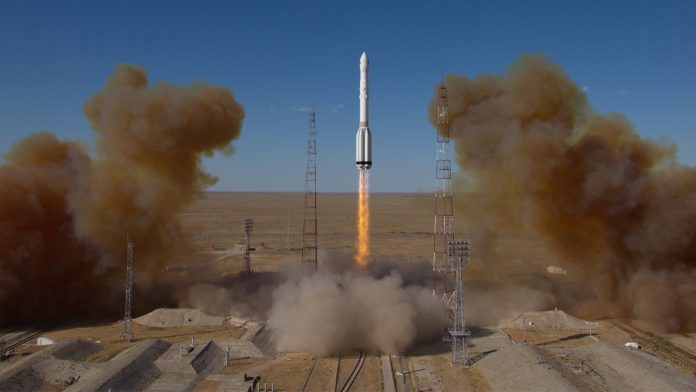First observations of the eROSITA X-ray telescope promise a breakthrough in our understanding of the energetic Universe.
AT 14:17 on 21 June 2019, the Russian-German Spektrum-Roentgen-Gamma (SRG) space mission successfully lifted off from the Baikonur cosmodrome. On-board is the eROSITA X-ray telescope, which was developed and built by a consortium of German institutes led by the Max Planck Institute for Extraterrestrial Physics (MPE). Its mission: to reveal the properties of ‘dark energy’, by studying the large-scale structure of the Universe and testing cosmological models.
Already the first-light combined X-ray images of both close-by and distant objects, revealed to the public on October 22nd, showed remarkable details and an excellent image quality of the wide-field eROSITA X-ray telescope. On 8 December 2019, after an extensive program of commissioning, calibration and performance verification, the satellite has begun observing the sky in continuous scanning mode. As SRG follows the revolution of Earth around the Sun, it will perform eight complete surveys of the whole sky, one every six months, for the next four years. Over that time, eROSITA should discover approximately 100,000 clusters of galaxies, around three million accreting supermassive black holes and half a million active, X-ray emitting stars.
The main scientific goal of eROSITA is to reveal the properties of ‘dark energy’, the mysterious force that causes the expansion of the Universe to accelerate, by studying the large-scale structure of the Universe. It will achieve this task by observing X-rays, which are produced abundantly by the hot, tenuous gas that permeates clusters of galaxies, the most massive structures known in the Universe. In the current cosmological model, clusters of galaxies form by aggregation from smaller galaxies and group together. By observing a sufficiently large number of them, the scientists at MPE will be able to reconstruct their growth history, which is very sensitive to the detailed properties of dark energy and dark matter.
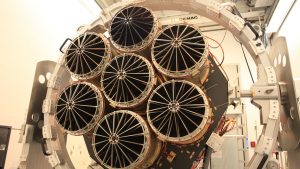
Copyright: © MPE
The telescope
Answering these questions requires a highly sensitive X-ray telescope: eROSITA has seven identical X-ray ‘eyes’, each combining a mirror module with 54 nested mirror shells and an X-ray camera placed at its focus. The surface of each mirror shell had to be extremely smooth – the surface ‘roughness’ is 0.3nm and is coated with gold to increase the reflectivity for grazing incidence of the incoming X-rays.
The special X-ray cameras, which were also developed and built at MPE, contain highly sensitive X-ray CCDs manufactured from high-purity silicon, and are controlled by sophisticated, purpose-built electronics, allowing on-board data compressing, and real-time screening of cosmic rays, an unwanted background in the X-ray images. The cameras allow images to be produced over a field of one square degree, matching the wide imaging capabilities of the mirrors. This large field of view will allow eROSITA to perform, during its four years of survey operations, the first deep imaging all-sky survey in the medium energy X-ray range (from approximately 0.2 up to 10 keV) with an unprecedented spectral and angular resolution.
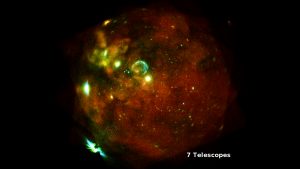
Copyright: © F.Haberl, M. Freyberg und C. Maitra, MPE/IKI
First light
100 days after launch, on 21 October 2019, eROSITA completed its 1.5m kilometers journey to the second Lagrange point (L2) of the Earth-Sun-system and entered its target orbit. All seven eROSITA X-ray telescope modules with their custom-designed CCD cameras had been observing the sky simultaneously since October 13. The eROSITA ‘First Light’ images were obtained in a series of exposures of all seven telescope modules with a combined integration time of about one day for both the Large Magellanic Cloud (LMC), and the A3391/3395 system of interacting clusters of galaxies at a distance of around 800 million lightyears.
In our neighboring galaxy, the LMC, eROSITA not only shows the distribution of the diffuse hot gas, but also some remarkable details, such as supernova remnants like SN1987A. The eROSITA image now confirms that this source is becoming fainter, as the shock wave produced by the stellar explosion in 1987 propagates through the interstellar medium. In addition to a host of other hot objects in the LMC itself, eROSITA also reveals a number of foreground stars from our own Milky Way galaxy as well as distant Active Galactic Nuclei, whose radiation pierces the diffuse emission of the hot gas in the LMC.
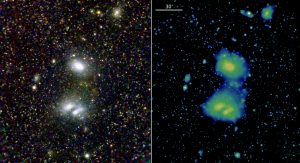
Reaching further out into the Universe, the eROSITA image of the A3391/3395 system of interacting clusters of galaxies highlights the dynamical processes, which lead to the formation of gigantic structures in the Universe. The clusters, appearing as large, elliptical nebulae in the images, span tens of millions of lightyears across, and contain thousands of galaxies each. Clusters are one of the main science targets for eROSITA; astronomers expect to find some 100,000 of them, an unprecedentedly large inventory, needed in order to constrain the cosmological growth of structures in the Universe, and provide new clues on the nature of dark energy.
To confirm those predictions for the all-sky survey, eROSITA scientists have also performed a number of test observations over the few weeks between ‘first light’ and the start of the all-sky survey in December. Among those, a mini survey called eFEDS (eROSITA Final Equatorial Depth Survey) was devised in order to image a small patch of the sky to the same depth expected at the end of the four years all-sky survey. The eFEDS data show the same stunning image quality demonstrated by the eROSITA first light. More importantly, they allowed the scientists to confirm with great accuracy the sensitivity of the X-ray telescope to its main target classes.
Over an area of just 1/300 of the full sky, eROSITA revealed more than 18,000 point-like X-ray sources, around 85% of them being distant Active Galactic Nuclei (AGN) harboring growing supermassive black holes, and most of the remainder X-ray stars. The mini survey also discovered more than 400 clusters of galaxies (including a few at a redshift around one), easily recognisable from their extended, diffuse morphology in the sharp X-ray images.
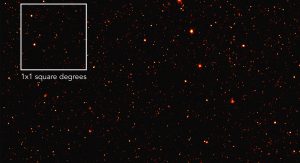
Copyright: © V. Ghirardini. MPE/IKI
The future
It took around four days of SRG/eROSITA observations to generate these maps, and it will take about 1500 more to make such exquisite maps for the whole sky. The analysis of the eFEDS images confirm that the eROSITA all-sky survey, if all goes according to plan, shall be able to meet its original science goals: studying the large-scale structure of the Universe, and measuring its expansion rate by counting clusters of galaxies and the distribution of AGN in space and time, while at the same time, revealing a large population of hot stars, neutron stars and stellar mass black holes scattered around the body of our Milky Way. After this survey, our view of the high-energy sky will never be the same.
About eROSITA
The development and construction of the eROSITA X-ray telescope was led by the Max Planck Institute for Extraterrestrial Physics with contributions from the Institute for Astronomy and Astrophysics of the University Tübingen, the Leibniz Institute for Astrophysics Potsdam (AIP), University Observatory Hamburg, and Dr. Karl Remeis Observatory Bamberg. The University Observatory Munich and the Argelander Institute for Astronomy of the University Bonn are also participating in preparing for eROSITA science. The Russian partner institute is the Space Research Institut IKI in Moscow; NPOL, Lavochkin Association, Khimky near Moscow, is responsible for the technical implementation of the whole SRG mission. The project is supported by the Russian and German space agencies, Roscosmos and the German Aerospace Center (DLR).
Dr Andrea Merloni
Scientist
Max Planck Institute for Extra-terrestrial Physics
+49 (0) 89 30000 3893
am@mpe.mpg.de
www.mpe.mpg.de/main
Please note, this article will also appear in the first edition of our new quarterly publication. Subscribe to our updates for free here.

